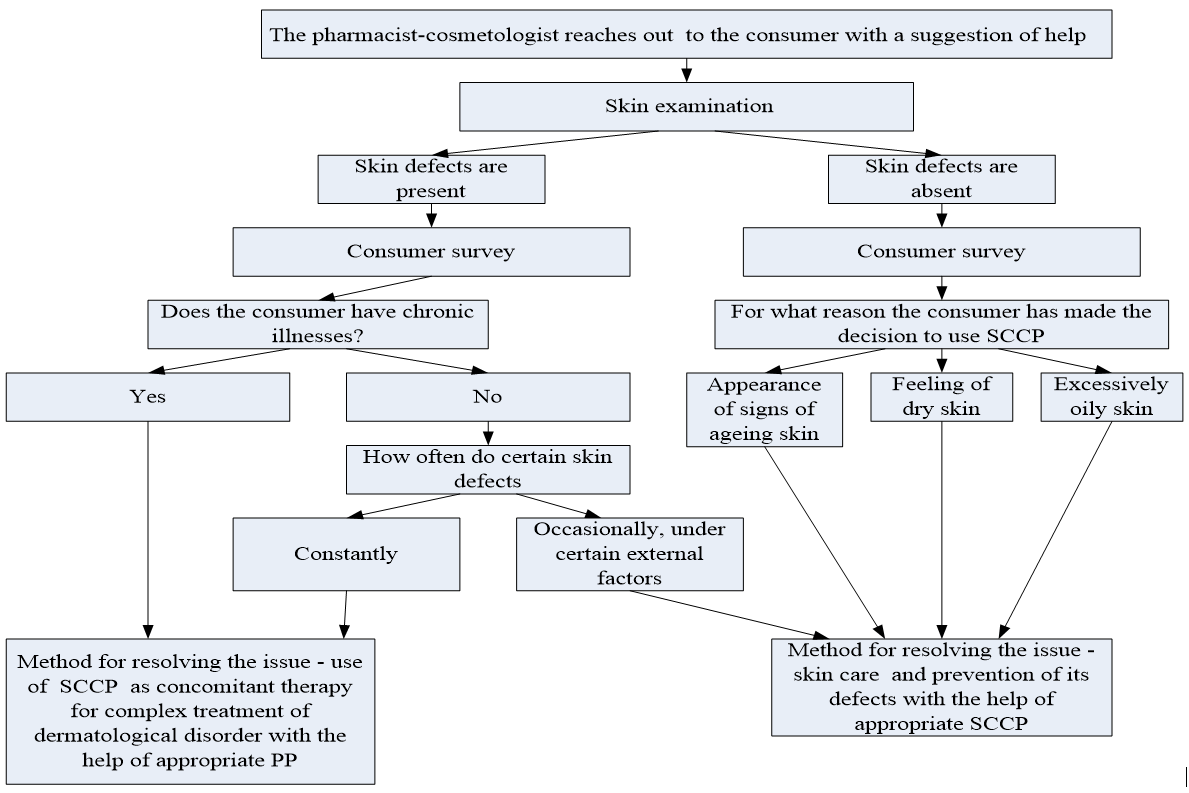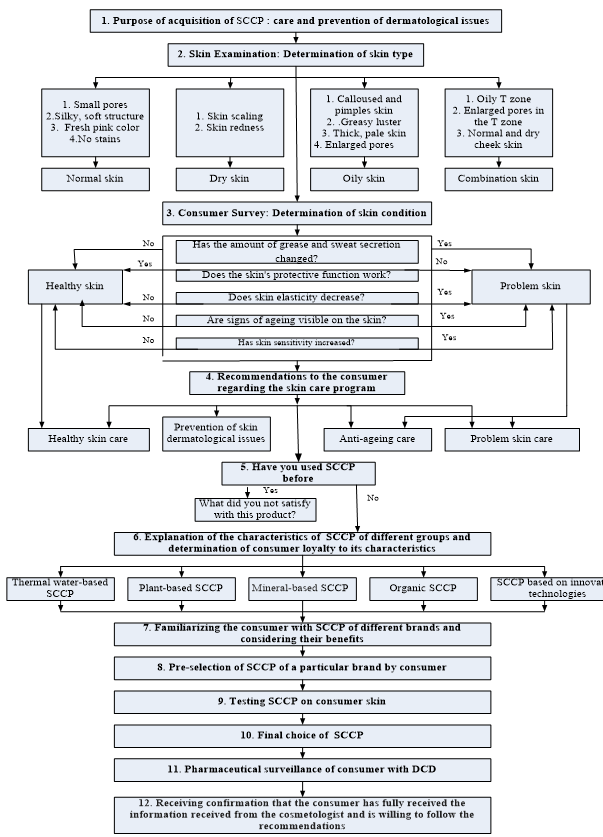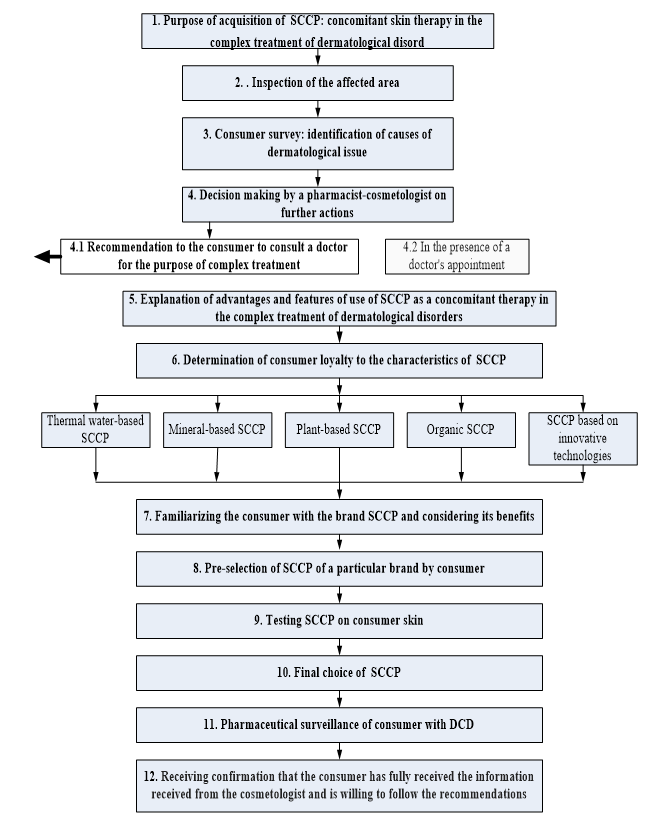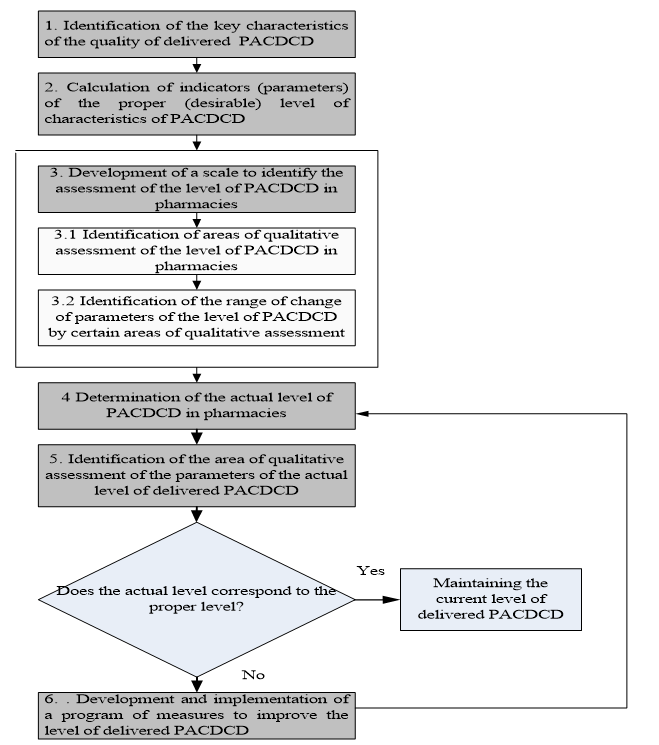Methodical approaches to the organization and quality assessment of pharmaceutical aid to consumers with dermatocosmetic disorders in pharmacies
Olga Posilkina*, Viktoriia Kotlyarova, Anastasiia Lisna, Olena Chechotka
Department of Management and Economics of enterprise, National University of Pharmacy, Kharkov, Ukraine.
ABSTRACT
According to the research findings, it has been found that consumers with dermatocosmetic disorders go to pharmacies not only to purchase the necessary product but also to get advice on the existing dermatological issue, the ways to deal with it and to choose the type of product by using which the issue may be resolved. Therefore, in pharmacies, which have skincare and correction products (cosmeceuticals) in their product range, should provide conditions for the organization of pharmaceutical aid. The proposed scientific and methodological approaches make it possible to evaluate the degree of conformity of the actual level of providing pharmaceutical aid to consumers with this medical condition with the desired (proper) level and to identify the resources of its improvement.
Keywords: Consulting, Marketing information, Logistic services, Quality of service
Introduction
According to the Good Pharmacy Practice provisions, pharmacies (P) are required to provide through their activities “guarantees of promoting the health and quality of life” of their patients [1]. The modern technology of the implementation of this task is the organization of pharmaceutical aid (PA) in pharmacies (P). For the first time, the definition of PA as a new scientific and practical area in the pharmaceutical support of the population was given in the research by C. D. Helper and L. D. Strand. Based on the studies of literature sources [2-6], it can be concluded that by the term “PA” they understand “the activity during which a pharmacist assumes responsibility for medicines for the patient, namely: evaluates their reliability and effectiveness depending on the condition of the patient's health; develops a permanent plan of medical care for the patient”. This can be done, firstly, under the condition of studying the consumers’ (patients’) needs and, accordingly, by developing programs for РА delivery in view of the peculiarities of the behavior of different consumer groups; secondly, by organizing the delivery of an adequate level of pharmaceutical services in pharmacies (P). That is, pharmacies must implement a quality management system, one of the principles of which is decision making based on data and information analysis. Under these conditions, the problem is growing urgent in developing scientific and methodological approaches to the organization of evaluation of the status of providing РА to consumers (patients) to monitor its level and ensure the proper quality.
Research conducted by the authors of customer (patient) services in pharmacies (P) has shown that, for instance, consumers with dermatocosmetic disorders (DCD) visit them not only to purchase a suitable product, but also to obtain advice on an existing dermatological issue, methods for its solution, selection of the appropriate remedy, by using which the issue may be resolved [7]. Recently, dermatocosmetic issues of consumers (patients) are increasingly being resolved by using skincare and correction products (SCCP) (cosmeceuticals) that are a class of pharmaceutical products being singular in terms of formulation, substance or technology that affect the deep skin layers and provide not only a therapeutic but also aesthetic effect [7].
Although SCCP (cosmeceuticals) are not classified as pharmaceutical products according to the Ukrainian legislation, at the same time they have certain differences from traditional pharmaceutical products (PP) [8]. The specific feature of this class of PP is the purpose and object of the action, the type of action, and their always innovative (original) character. In addition, SCCP (cosmeceuticals) are not included in the basic product range of pharmacies (P) and a significant number of consumers identify them with cosmetic products, considering that the term “SCCP (cosmeceuticals)” is simply a successful marketing ploy. Considering the fact that SCCP (cosmeceuticals) include active pharmaceutical ingredients and exert not only aesthetic but also pharmacological effect, they require courses of use and their incorrect use can have serious negative consequences for the patient. The problem is growing more urgent of developing approaches adapted to this group of pharmaceutical products to provide appropriate РА and an algorithm for assessing its quality.
Materials and Methods:
Methods were used in the research: content analysis to determine the essence of the concept of "pharmaceutical aid", the expert survey to determine the importance of individual marketing information, consulting and logistic services.
Results:
Proceeding from the basic principles of Good Pharmacy Practice and the findings of the conducted content analysis, it is suggested to understand by the term “РА to consumers (patients) with dermatocosmetic disorders (PACDCD)” a complex of marketing information, consulting and logistic services (MICLS) that are aimed at providing consumers with DCD with necessary information regarding the characteristics and features of SCCP (cosmeceuticals) and the formation of their attitudes towards the responsible management of these products, along with the provision of physical availability of necessary PP and SCCP (cosmeceuticals) in sufficient quantity, at the right time and in the right place. The basic conditions for providing a proper PACDCD are: forming a reasonable (optimum) range of SCCP (cosmeceuticals) for a particular P; ensuring the physical availability of the required SCCP (cosmeceuticals); providing a complex of MICLS at the point of sale for making informed decisions by consumers about the selection, purchase, and use of SCCP (cosmeceuticals); providing pharmaceutical surveillance to consumers with DCD.
The content of the consulting support to be provided to the consumer (patient) with DCD in pharmacies depends on the nature of the medical condition (disorder) the patient has presented with. First of all, the pharmacist-cosmetologist should determine the method of addressing the dermatological issue (Fig. 1).

Fig. 1. Algorithm of communication between the pharmacist-cosmetologist and the consumer to determine the method of addressing their dermatocosmetic issue.
If a decision has been made that after the initial examination of the skin the patient (the consumer) needs special skincare and prevention of the threat of dermatological pathology, the communication between the pharmacist-cosmetologist and the consumer (patient) should be performed according to the algorithm shown in Fig. 2. If a dermatological pathology is identified and a decision is made that the consumer requires complex pharmacotherapy with the use of PP and, simultaneously, SCCP (cosmeceuticals) as concomitant therapy, consulting support by the pharmacist-cosmetologist regarding the selection of SCCP (cosmeceuticals) by the consumer should be performed according to the algorithm shown in Fig. 3.
As already noted, the important components of a proper PACDCD are the physical availability of the required SCCP (cosmeceuticals) in pharmacies (P) and the availability and use of the whole complex of MICLS at the point of sale for making a well-informed decision by the consumer (patient) regarding the selection, purchase, and use of a particular SCCP (cosmeceuticals).

Fig. 2. Algorithm of consulting support by the pharmacist-cosmetologist regarding the selection of SCCP (cosmeceuticals) by the consumer for skincare and prevention of a dermatocosmetic issue.

Fig. 3. Algorithm of consulting support for the selection of SCCP (cosmeceuticals) by the consumer during the complex treatment of a dermatological disorder.
As of today, in the range of pharmacies there is a wide choice of marketing communications for the provision of PA: logistic service, merchandising, information materials, consulting, additional services, and educational activities [9, 10]. However, given that pharmacies (P) are not only social but also commercial organizations, pharmacies of various types are forced to determine the list of MICLS appropriate for them, which correspond to the level of their resources and the behavior patterns of consumers with DCD, who most frequently visit pharmacies of a certain type. Since our studies have proved the dependence of the strategy of formation of the range of SCCP (cosmeceuticals) and behavior models of the consumer with DCD in pharmacies, depending on their location [7], the latter has been divided into three types in our work: 1) pharmacies located in the city center at the cross-ways; 2) pharmacies located in supermarkets; and 3) pharmacies located in bedroom communities. The list of appropriate MICLS justified by our work according to the research findings for the provision of PACDCD depending on the type of pharmacies is given in Table 1.
In order to determine the level of provision of PACDCD in pharmacies (P), the key characteristics of the quality of the aid should be monitored. We used an expert survey method to identify key characteristics. The justified number of experts, which was determined by the method [11] was 405. The assessment of the consistency of the experts’ opinions was carried out using the coefficient of concordance, which was 0.84 in our study. The non-randomness of the experts' findings was confirmed by the high value of the Pearson coefficient of 134.5. As a result of the expert survey, it has been found that the most important characteristics of the quality of РА delivered to consumers with DCD are: for the “consulting support” service: professionalism of the pharmacist-cosmetologist, the nature of communication between the pharmacist-cosmetologist (pharmacist) and the consumers with DCD; for “merchandising” and “information materials” services: their exhaustiveness, sufficiency, understandability, usefulness; for “additional services: the exhaustiveness, accuracy of interpretation of results of diagnostics of a skin condition; for “educational activities”: the understandability and usefulness of the information provided; for the “quality logistic service”: the availability of the required SCCP (cosmeceuticals) in pharmacies (P) and the speed of their delivery.
Our algorithm, suggested based on the identified key characteristics, for assessing the quality of delivered PACDCD in pharmacies is shown in Fig. 4.
|
Table 1. List of MICLS appropriate for pharmacies of different types |
||||
|
Type of pharmacy |
Components of the model of consumer behaviour |
List of appropriate MICLS |
||
|
|
Pharmacy attraction factors for consumers |
Main objective of the acquisition of PP by consumers |
Specific features of consumer behaviour |
|
|
Pharmacies located in the city center |
Wide and deep range of SCCP (cosmeceuticals) Additional services Positive image of pharmacy |
DCD treatment, problem skin care, DCI prevention, anti-ageing care |
Carefully study additional information at the point of sale Appeal to pharmacist-cosmetologists for: - determination of skin condition and diagnosis of DI, - selection of PP; Attempt to obtain information on options for resolving DI; Are interested in newly-designed products. Stay in pharmacies for an average of 30 minutes. |
Merchandising, including display of goods Information materials (including POS) Consulting support Additional services Educational activities Quality logistic services |
|
Pharmacies located in supermakets |
Wide range of SCCP (cosmeceuticals) Speed of service rate |
Normal skin care, anti-ageing care |
Appeal to consultants rarely for the choice of SCCP (cosmeceuticals). They are practically not interested in additional information. Stay in pharmacies for an average of no more than 10 minutes. |
Merchandising, including display of goods Information materials (including POS) Consulting support Quality logistic services |
|
Pharmacies located in bedroom communities |
Possibility to purchase urgently needed pharmaceutical products |
Solution of hygienic and cosmetic problems of skin care |
They try to independently study the products located on the racks. They scarcely appeal to pharmacists. |
Merchandising, including display of goods Information materials |

Fig. 4. Algorithm of assessing the quality of delivered PACDCD in pharmacies
Following the questionnaire survey results according to the fixed amount method on the basis of the constructed matrix of ranks, the weight coefficients of the key characteristics of the quality of delivered PACDCD in pharmacies were calculated. The coefficients of the significance of these characteristics, determined on the basis of the expert survey method, are as follows: “Consulting support”: 0.23; “Quality logistic services”: 0.18; “Merchandising”: 0.17; “Information materials”: 0.10; “Additional services”: 0.16; “Educational activities”: 0.16.
According to the proposed method, the assessment of the quality of delivered PACDCD, except for the “Quality logistic service”, is proposed to be performed on a five-point scale. The polarity of the assessment is as follows: the higher the level of РА, the higher the point. According to the level of logistic services, it is appropriate to perform the assessment as follows: the required SCCP (cosmeceuticals) is constantly available in pharmacies: 4 points; the required SCCP (cosmeceuticals) in pharmacies is not available, but it can be delivered at a certain time: 3 points; the required SCCP (cosmeceuticals) in pharmacies is missing, but the pharmacist-cosmetologist (pharmacist) has offered its delivery: 2 points; the required SCCP (cosmeceuticals) is missing and cannot be delivered at a certain time: 1 point. In determining the proper level of PACDCD in pharmacies, each key characteristic of the quality of PACDCD (except for the indicator of the quality of logistic service) is rated using the highest point.
The calculation of the indicator of the quality of delivered PACDCD in pharmacies (Оя) is proposed to be performed according to the formula:
 (1)
(1)
where: Qn is the key characteristics (constituents) of PACDCD, which are calculated using the formula:
 (2)
(2)
where is the i-th parameter of PACDCD in pharmacies by the n-th key characteristic;
n is the number of key characteristics of PACDCD being appropriate for a certain type of pharmacies (from 1 to 6);
is the number of parameters assessed by the i-th key characteristic of PACDCD;
is the coefficient of significance (weight coefficient) of the i-th key characteristic of PACDCD  (Ln=1)
(Ln=1) .
.
The proposed assessment scale of the quality of PACDCD delivered in pharmacies of different types is given in Table 2.
|
Table 2. The proposed scale for assessing the appropriate quality of services provided in pharmacies of different types. |
|||
|
When promoting SCCP (cosmeceuticals) |
Type of pharmacy |
||
|
|
Located in the city center |
Located in the supermarket |
Located in the bedroom community |
|
1 |
2 |
3 |
4 |
|
Consulting support: - professionalism of the pharmacist-cosmetologist - level of communication between the pharmacist-cosmetologist and the consumer |
5
5 |
5
5 |
-
- |
|
Total |
10 |
10 |
- |
|
Quality logistic service |
4 |
4 |
- |
|
Merchandising - exhaustiveness of information - sufficiency of information - understandability of information - usefulness of information |
5 5 5 5 |
5 5 5 5 |
5 5 5 5 |
|
Total |
20 |
20 |
20 |
|
Information materials - exhaustiveness of information - sufficiency of information - understandability of information - usefulness of information |
5 5 5 5 |
- - - - |
- - - - |
|
Total |
20 |
- |
- |
|
Additional services - exhaustiveness - accuracy of interpretation of results of diagnostics of a skin condition |
5 5 |
- - |
- - |
|
Total |
10 |
- |
- |
|
Educational activities - understandability - usefulness |
5 5 |
- - |
- - |
|
Total |
10 |
- |
- |
Source: our own development
An example of how to calculate the appropriate level of delivered PACDCD:
- for pharmacies located in the city center:
=4/1×0.18+20/4×0.17+20/4×0.1+10/2×0.23+10/2×0.16+10/2×0.16=4.82;
- for pharmacies located in supermarkets:
=4/1×0.18+20/4×0.17+0/4×0.1+10/2×0.23+0/2×0.16+0/2×0.16=2.72;
- for stand-alone pharmacies located in bedroom communities:
=4/1×0.18+20/4×0.17+0/4×0.1+0/2×0.23+0/2×0.16+0/2×0.16=1.57.
Stage 2. Development of the PACDCD quality assessment scale for pharmacies of different types. To achieve this, we have proposed a verbal-numeric scale based on the Harrington scale [12], taking into account the appropriate list of MICLS for different types of pharmacies. It is proposed to define the limits (Gmax, Gmin) of the quality assessment of delivered PACDCD according to the formulas:
 ,
, (3)
(3)
 (4)
(4)
where:  is the maximum level of appropriate PACDCD in pharmacies of a certain type (for high-traffic pharmacies: 4.82; for pharmacies located in supermarkets: 2.72; for stand-alone pharmacies located in bedroom communities: 1.57);
is the maximum level of appropriate PACDCD in pharmacies of a certain type (for high-traffic pharmacies: 4.82; for pharmacies located in supermarkets: 2.72; for stand-alone pharmacies located in bedroom communities: 1.57);
is the minimum level of appropriate PACDCD in pharmacies of a certain type (for high-traffic pharmacies: 3.88; for pharmacies located in supermarkets: 2.22; for stand-alone pharmacies located in bedroom communities: 1.26);
Gх is the limits of the Harrington scale (very low level: 0-0.2; low level: 0.2-0.37; medium level: 0.37-0.64; high level: 0.64-0.8; very high level: 0.8-1.0).
The quality assessment scale of delivered PACDCD in pharmacies suggested based on the conducted calculations is shown in Table 3.
|
Table 3. Quality assessment scale for pharmacies in terms of different types of pharmacies |
|||||
|
Type of pharmacy |
Very low level |
Low level |
Medium level |
High level |
Very high level |
|
Located in the city center |
0-0.96 |
0.96-1.78 |
1.78-3.0 |
3.0-3.88 |
3.88-4.82 |
|
Located in supermarkets |
0-0.54 |
0.54-1.0 |
1.0-1.55 |
1.55-2.2 |
2.2-2.72 |
|
Stand-alone pharmacies located in bedroom communities |
0-0.3 |
0.3-0.58 |
0.58-1.0 |
1.0-1.26 |
1.26-1.57 |
The proposed scales may be adjusted by the change in the priorities of the consumers (patients) with DCD or the development of РА tools. If the indicator of the actual level of PACDCD falls into the “high level” and “very high level” ranges of qualitative assessment, pharmacies should continue to support the achieved level of РА. However, if the actual assessment of the level of PACDCD does not fall into these two ranges, a program of measures to improve the level of РА in pharmacies is required to be developed.
Conclusion:
The definition of the term PACDCD in pharmacies has been proposed. It has been found that the basic conditions for providing a proper PACDCD are: forming a reasonable (optimum) range of SCCP (cosmeceuticals) for a particular P; ensuring the physical availability of the required SCCP (cosmeceuticals); providing a complex of MICLS at the point of sale for making informed decisions by consumers about the selection, purchase and use of SCCP (cosmeceuticals) (PP); providing pharmaceutical surveillance to consumers with DCD.
It has been established that the content of communication between the pharmacist-cosmetologist and the consumer (patient) in pharmacies depends on the nature of the medical condition (disorder) the patient has presented with.
It has been proved that pharmacies of different types should determine the list of PACDCD key characteristics for them, which corresponds to the level of their resources and the behavior patterns of consumers with DCD, who most frequently visit these pharmacies.
It has been found that the most important characteristics of the quality of РА delivered to consumers with DCD are: for the “consulting support” service: professionalism of the pharmacist-cosmetologist, the nature of communication between the pharmacist-cosmetologist (pharmacist) and the consumers with DCD; for “merchandising” and “information materials” services: their exhaustiveness, sufficiency, understandability, usefulness; for “additional services: the exhaustiveness, accuracy of interpretation of results of diagnostics of a skin condition; for “educational activities”: the understandability and usefulness of the information provided; for the “quality logistic service”: the availability of the required SCCP (cosmeceuticals) in pharmacies and the speed of their delivery.
Conflict of interest:
All authors declare that there is no conflict of interest among the authors.
References
- Good Pharmacy Practice: Pharmacy Service Quality Standards (International Federation of Physical Medicine/WHO Joint Instruction on GPP). URL:zakon.rada.gov.ua/laws/show/897_009 ( accessed: January 22, 2019).
- Hepler CD. The third wave inpharmaceutical education and the clinicalmovement. Am. J. Pharm. Ed. 1987; 51: 369–385.
- Hepler CD, Strand LM. Opportunities andresponsibilities in pharmaceutical care. Am. J.Pharm. Ed. 1989; 51: 7–15.
- Hepler CD. Clinical pharmacy, Pharmaceutical Care and the Quality of Drug Therapy. Pharmacotherapy. 2004; 24: 1491–1498.
- Strand LM. Pharmaceutical Care: an introduction. Kalamzoo, MI; Upjohn Company, 1992.
- Franklin BD. Defining clinical pharmacy and pharmaceutical care. Pharm. World Sci. (Editorial). 2005; 27: 137.
- Posilkina OV, Kotlyarova VG, Chechotka OV. Scientific and methodological approaches to forming a strategy for managing the range of medical cosmetic products in pharmacies. Social pharmacy in health care. 2019; 5: 61-68.
- Posilkina OV, Kotlyarova VG, Chechotka OV. Investigation of the essence and basic characteristics of medical and cosmetic products. Pharmacist. 2016; 3-4: 21-2
- Mnushko ZM, Pestun IV. Efficiency of the modern model of marketing complex in pharmacies. 2018; 6 (24): 45-48.
- Lenskold JD. Customer Centric Marketing – ROI. The right measure for marketing. Marketing Management. New-York : McGraw-Hill Education; 2004.
- Geyets VM, Klebanova TS, Chernyak OI. Models and methods of socio-economic forecasting. Kharkiv: VD INZHEK; 2005.
- Mickiewicz A. Scales of indicators without planned value. Enterprise management. [serial on the Internet]. 2018 [cited 2019 Dec 15]; 4. [about 10 p.]. Available from: http://upr.ru/article/kontseptsii-i-metody-upravleniya/1932.html.
Contact Meral
Meral Publications
www.meralpublisher.com
Davutpasa / Zeytinburnu 34087
Istanbul
Turkey
Email: [email protected]